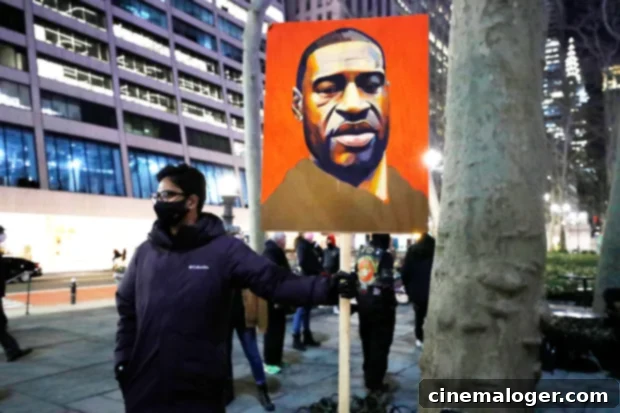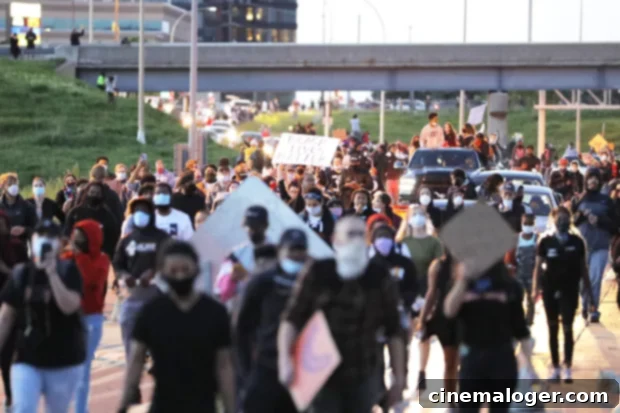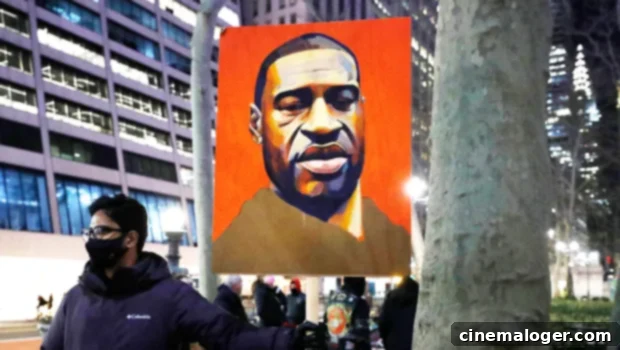The Enduring Legacy of George Floyd: From Tragic Death to Global Demand for Justice
On May 25, 2020, the world witnessed a devastating act that would ignite a global movement for justice and racial equality. George Floyd, a 46-year-old Black man, died in Minneapolis, Minnesota, after a white police officer, Derek Chauvin, knelt on his neck for more than nine minutes. This horrific event, captured on bystander video, sent shockwaves across the globe, sparking outrage, widespread protests, and an urgent call for accountability within law enforcement. Nearly one year later, the pursuit of justice reached a critical stage as former Minneapolis police officer Derek Chauvin stood trial, charged with murder and manslaughter in Floyd’s death. As the public keenly awaited a verdict that would undoubtedly have significant implications for police reform and civil rights, it became imperative to understand the man George Floyd was, the tragic circumstances surrounding his unjust death, and the powerful, enduring legacy he left behind.
The Tragic Final Moments: An Unjust Death That Shook the World
The circumstances leading to George Floyd’s death began with a seemingly minor incident on May 25, 2020. Minneapolis police officers responded to a 911 call reporting a “forgery in progress” at a Cup Foods convenience store, alleging that Floyd had used a counterfeit $20 bill. Upon arrival, officers encountered Floyd, who was sitting in a parked car. The interaction quickly escalated. Floyd was removed from his vehicle, handcuffed, and eventually pinned to the ground by officers. It was at this point that former officer Derek Chauvin applied his knee to Floyd’s neck, a position he maintained for an excruciating period that would forever be etched into the public consciousness.
Disturbing footage, captured by courageous witnesses that night, graphically showed Floyd pleading for his life. Over and over, he could be heard uttering the desperate words, “please, please I can’t breathe.” He called out for his mother, complained of pain in his stomach and neck, and repeatedly articulated his inability to draw breath. Despite his palpable distress and pleas, which grew weaker with each passing minute, Chauvin, then 45, maintained his position. Three other officers—Tou Thao, J. Alexander Kueng, and Thomas Lane—stood by, observing the scene without intervening to provide aid or remove Chauvin from Floyd’s neck. This inaction further fueled public anger and became a central point of subsequent legal proceedings against them.
For a harrowing nine minutes and 29 seconds, Chauvin’s knee remained on Floyd’s neck as Floyd progressively lost consciousness. Eventually, Floyd became unresponsive, his body limp. Emergency medical services were called to the scene, but despite efforts, Floyd was pronounced dead in an ambulance on the way to the Hennepin County Medical Center. The official cause of death, as determined by the Hennepin County Medical Examiner and corroborated by an independent autopsy commissioned by Floyd’s family, was “asphyxia due to neck and back compression that led to a lack of blood flow to the brain.” This definitive conclusion underscored the direct role of Chauvin’s actions in Floyd’s demise, transforming a minor alleged infraction into a profound and fatal injustice that highlighted systemic issues within policing.

The Pursuit of Justice: Derek Chauvin’s Historic Trial
In the immediate aftermath of George Floyd’s death, former Minneapolis police officer Derek Chauvin was swiftly fired from the police department, alongside the three other officers involved. This dismissal marked the beginning of a complex and highly scrutinized legal battle. Chauvin was subsequently charged with several offenses, including second-degree unintentional murder, third-degree murder, and second-degree manslaughter. These charges reflected the varying degrees of culpability attributed to his actions, recognizing both the intent to cause harm (though not necessarily to kill) and the extreme negligence involved.
The path to trial was not without its legal twists and turns. Chauvin initially attempted to secure a plea deal with the Department of Justice, which would have seen him plead guilty to a lesser charge in exchange for a lighter sentence. However, this attempt was ultimately rejected, pushing the case towards a full trial. Chauvin pleaded not guilty to all charges, asserting that he had followed police training and that Floyd’s death was attributable to pre-existing health conditions and drug use, a claim vigorously contested by the prosecution and medical experts.
The trial itself, which commenced on March 28, 2021, became a focal point of national and international attention. It was a landmark case, not only for its high-profile nature but also for its broader implications regarding police accountability and systemic racism within the criminal justice system. The proceedings were meticulously documented, with powerful testimony from eyewitnesses, medical professionals, and policing experts. Prosecutors presented compelling evidence, including the harrowing bystander video, emphasizing the excessive force used and Chauvin’s apparent disregard for Floyd’s life. If convicted on the most serious charge of second-degree murder, Chauvin faced a potential sentence of up to 40 years in prison, with sentencing guidelines influenced by his lack of prior criminal record and other mitigating or aggravating factors. The world watched, understanding that the verdict would echo far beyond the Minneapolis courtroom, shaping discussions on justice and law enforcement for years to come.
From Minneapolis to the World: Floyd’s Death Ignites Global Protests and the Black Lives Matter Movement
The footage of George Floyd’s murder did not just elicit sorrow; it ignited a powerful, unprecedented wave of anger and activism that swept across the United States and extended globally. Within days, Black Lives Matter demonstrations erupted in nearly all 50 states and in numerous countries worldwide. These protests were a visceral response to Floyd’s death, but they quickly evolved into a broader outcry against systemic racism, police brutality, and the disproportionate killing of Black individuals by law enforcement. Protesters marched not only for justice for Floyd but also for other Black victims whose lives had been cut short, including Breonna Taylor, Ahmaud Arbery, and countless others whose names became rallying cries.
The demonstrations varied in size and scope, ranging from peaceful assemblies and vigils to large-scale marches that shut down city streets. Millions of people, diverse in age, race, and background, took to the streets, demanding fundamental changes to policing practices, an end to racial profiling, and greater accountability for officers involved in misconduct. Slogans like “Black Lives Matter,” “No Justice, No Peace,” and “Say His Name” resonated loudly, underscoring the collective frustration and the urgent need for reform. Cities like Minneapolis, New York, Los Angeles, and Washington D.C. saw some of the largest and most sustained protests, with demonstrations often lasting for months.
However, these peaceful demonstrations were frequently met with significant pushback, and at times, violence from police forces. Law enforcement agencies in many cities responded to protesters with tactics that drew widespread condemnation, including the deployment of tear gas, rubber bullets, pepper spray, and flash-bang grenades to disperse crowds. Reports and videos emerged of clashes between officers and demonstrators, leading to numerous arrests and injuries. One particularly controversial incident involved the New York City Police Department, which was accused of trapping thousands of demonstrators on the Manhattan Bridge between Brooklyn and Manhattan, only to arrest them en masse as they attempted to leave, citing violations of city-mandated curfews. These aggressive responses by police further highlighted the very issues of excessive force and lack of de-escalation that the protests sought to address, inadvertently fueling the movement’s resolve and bringing greater scrutiny to police practices nationwide and internationally.
Beyond the Headlines: George Floyd, The Man
While George Floyd’s name became synonymous with a movement for justice, it is crucial to remember the man himself—a loving father, a devoted son, a beloved friend, and a valued community member. Before his tragic death, Floyd was known to those around him as a “gentle giant,” a man of warmth and camaraderie. He had a deep sense of loyalty and a strong desire to make a positive impact on the lives of others. His friends and family consistently described him as someone who brightened any room he entered, known for his infectious smile and his kind, respectful demeanor.
Floyd had a history of working in security, and at the time of his death, he was employed as security for Conga Latin Bistro in Minneapolis. His colleagues and the establishment’s owner held him in high regard. Jovani Thunstrom, the owner of Conga Latin Bistro, expressed profound grief and loss, not just for an employee but for someone he considered a best friend. Thunstrom told CBSN Minnesota, “He was the type of guy he was friendly to everybody. He didn’t discriminate, whether you were Hispanic, you were Black, you were White, he treated everybody with respect and that’s what I love about him.” This sentiment was echoed by many who knew Floyd, painting a picture of a man who genuinely valued human connection and approached everyone with an open heart. He was remembered for his positive energy, his ability to diffuse situations with a calm presence, and his unwavering kindness, qualities that made his sudden and brutal death all the more agonizing for those who loved him.

A Fresh Start and an Enduring Legacy: Floyd’s Journey from Houston to Minneapolis
George Floyd’s journey to Minneapolis was driven by a desire for a new beginning. He had moved from his hometown of Houston, Texas, to Minnesota in search of better opportunities and a “fresh start,” as his girlfriend, Courteney Ross, shared with CBSN Minnesota. According to Ross, Minneapolis represented a place where people were “kind and open to him,” offering a welcoming environment for his aspirations. He found community and work, carving out a life for himself that tragically ended far too soon. His move underscored a universal human desire for growth and improvement, making his death not just a loss for his loved ones, but a profound blow to the promise of a better future.
Following his death, George Floyd’s memorial and funeral services became powerful testaments to his life and the widespread impact of his passing. A series of emotionally charged memorials culminated in a poignant funeral service held in Houston in early June 2020. Thousands gathered outside the private services, carrying signs of support and solidarity, their presence a solemn honor to his memory. The ceremonies drew immense public attention, reflecting the deep collective grief and the global demand for justice. Dignitaries, activists, and celebrities traveled to pay their respects, signaling the profound significance of Floyd’s life and death.
Reverend Al Sharpton delivered a powerful and impassioned eulogy during the Houston service, unequivocally calling Floyd’s death “not just a tragedy, but a crime.” Sharpton’s words resonated deeply, emphasizing the systemic issues at play and the need for relentless pursuit of justice. He addressed the attendees, stating, “This is a time that we need to understand that they are going to do everything they can to delay these trials to try to wear this family down. Until these people pay for what they did, we’re going to be there with them. Because lives like George’s do not matter until someone pays for taking their lives.” His message served as a powerful rallying cry, ensuring that the momentum for accountability would not wane. The funeral was also attended by now-President Joe Biden, who offered his condolences and support to the Floyd family, as well as by prominent celebrities like Tiffany Haddish and Jamie Foxx, whose presence further highlighted the widespread recognition of Floyd’s story and its monumental implications for civil rights and racial justice in America and beyond.
George Floyd’s name will forever be etched in history, not just as a victim of police brutality but as a catalyst for profound societal change. His death sparked a reckoning with racial injustice that continues to unfold, inspiring ongoing activism, legislative efforts for police reform, and a global conversation about human dignity and equality. While the pain of his loss remains, his legacy endures as a powerful reminder of the urgent work that still needs to be done to ensure that no one else suffers a similar fate and that true justice is served for all.
